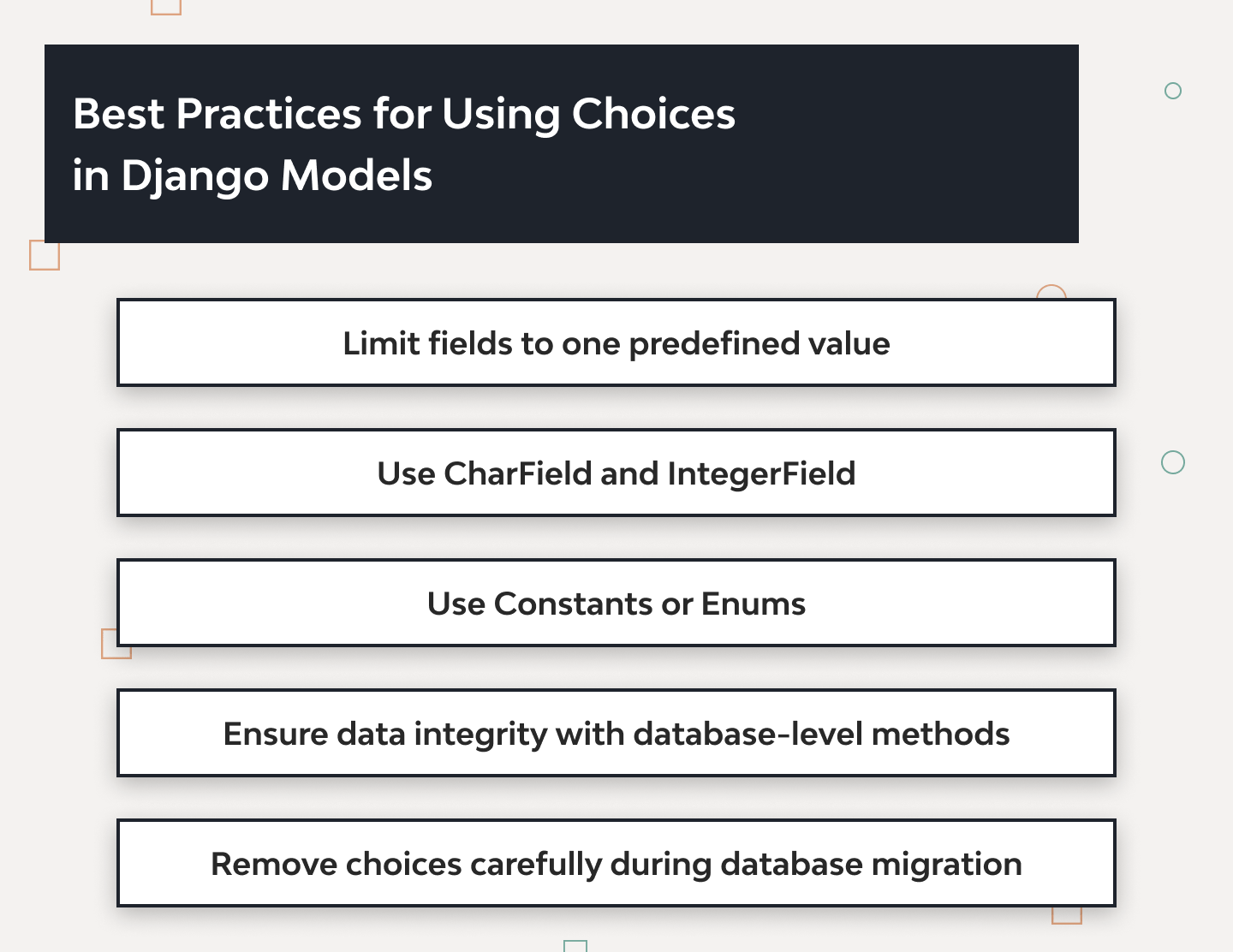Working with Django Models in Python: Best Practices

The Django framework provides a versatile toolset for managing your code and data. However, there are many strategies you can follow to build more stable products. Following best practices, Django models can become more secure, maintainable, and scalable.
As a backend engineer at Django Stars, I’ve accumulated a lot of knowledge about Django and Python. This article discusses some of the Django models management best practices that can help save you time and effort.
Best Practices for Django Models
These are some Django models best practices, including everyday tips and advanced techniques that I use to manage them. They range from fine-tuning fields and simplifying queries to improving security for object relationships.
Naming Django models in Python: best practices
Let’s start with the correct Django models name conventions. Although simple, these are invaluable for maintaining your databases.

Use singular nouns
A model should be named with a singular noun, representing a single entity. This makes understanding the relationship between models easier and avoids confusion.
Favor short names
Long model names are difficult to remember and type. Opt for concise names: for instance, use Feedback instead of CustomerFeedbackSurveyResponse.
Employ upper camel case
Django models follow Python-based Pascal case naming conventions, meaning each word in the name should start with a capital letter and contain no underscores.
Avoid abbreviations
Abbreviations often introduce needless ambiguity. Instead of writing Addr, use the complete term Address.
Refrain from using reserved words
Always avoid terms that are reserved by Django or Python. Don’t name models using terms like object, class, or get.
Align model and app name
Model names should be aligned with the application name without duplicating it. If the app name is Blog, model names could include Post, Comment, and Tag.
Best practices for naming relationship fields
Careful naming of relationship fields (special Django models field types establishing connections between different data models) contributes to a cleaner and more maintainable Django codebase.
Use plural naming for a ManyToManyField
A ManyToManyField should include a plural noun that reflects the related model. For instance, the field name could be Categories if a Product model has a ManyToManyField to a Category model.
Employ singular naming for a OneToOneField
A OneToOneField represents a one-to-one relationship and should be named using a singular noun that reflects the related model.
Stick to descriptive names
I always avoid vague or ambiguous names, as it helps prevent confusion when multiple relationship fields exist between the same models.
Use lowercase with underscores
Always use lowercase letters and underscores for Django model fields names to prevent case sensitivity issues with database backends. For example, full_name instead of FullName.
Be cautious with related_name
Avoid using the same name for a related_name argument and a field within one class. On the other hand, having the same field name in different classes doesn’t affect the model.
Best practices for using choices in Django models
Using the choices arguments correctly improves data integrity in Django models. It creates a central repository of predefined values, enforces model validation, and helps avoid hardcoding the values in the views. You can also use choices to limit user input per value to prevent unwanted queries.

Limit fields to one predefined value
When composing a list of tuples, use choices to define the valid values and human-readable names. This simple method minimizes the risk of inconsistent data entry.
Use CharField and IntegerField
While choices can be used with any field type, I prefer using CharField (string field storing text values) and IntegerField (numeric fields for integer values). Using choices with CharField can avoid using cryptic codes or abbreviations, while IntegerField helps avoid arbitrary numbers.
Use Constants or Enums
Defining the values as Constants or Enums helps make choices more maintainable and easily updatable. It also helps avoid hardcoding choice values throughout the codebase, which leads to many headaches and errors. For example, instead of using (‘A’, ‘Available’), use (AVAILABLE, ‘Available’), where AVAILABLE is a defined constant.
Ensure data integrity with database-level methods
Choices don’t enforce constraints at the database level. While choices validate and display field values in forms and admin interfaces, their use can cause unexpected behavior. It’s better to ensure data integrity via other database-level methods like constraints, triggers, and custom validators.
Remove choices carefully during database migration
The choices argument doesn’t alter the database schema, meaning you don’t need to perform database migrations when choices are added or removed. However, removal might cause errors in existing records that use old or removed choices. The solution might be to write a script that updates all records or deletes ones that are no longer relevant.
Best practices of Django models blank vs null values
In new database models, both null and blank are set to False. These two values are easy to confuse, but they’re quite different.
Store null values
In Django, the null argument indicates whether a database column can store null values. Setting null=False means the price column cannot have null values in the database. Meanwhile, the default value of null is False for most field types, except for the ForeignKey, OneToOneField, and ManyToManyField.
Use blank for empty fields in forms
The blank argument is a Boolean validation-related value determining if the field can be empty. For example, if a Product model has a field named description that is a TextField, setting blank=True means that the description field can be left blank or empty in forms, indicating that the product has no description.
Stick to empty strings
A common misconception is that setting null=True on a CharField or TextField would allow no data. However, both null and an empty string would signify no data, creating needless ambiguity. It’s better to default to an empty string for these field types.
Using Meta class in Django models: best practices
The Meta class is a nested class inside a model class that provides metadata and configuration options for the model.

Prefer common use attributes
I explicitly name the model and the fields. This can be done with verbose_name and verbose_name_plural — human-readable names for the model used in the admin interface and error messages. Another way is to use app_label to specify the app’s name for migrations.
Use default sorting of objects
Setting the ordering attribute in your model’s Meta class helps organize how objects will be listed by default. For instance, ordering = (‘name’, ‘-price’) sorts objects by name in ascending order and by price in descending order. However, be cautious — sorting can impact performance. If you need it, consider adding an index for quicker retrievals.
Avoid errors with custom table names
Using the db_table attribute lets you define the name of the database table for your model, like db_table = ‘shop_product’. This is a handy way to avoid table name clashes in your database.
Use unique_together for multi-column constraints
Employing UniqueConstraint instead of the older unique_together helps enforce uniqueness in multi-column fields. This ensures there can’t be two instances of the model with identical values. It works at the database level, adding an extra layer of integrity.
Boost query performance with index_together
The indexes option can speed up queries. By using indexes instead of deprecated index_together, you can improve query performance for specific combinations of fields (like names, categories, and statuses).
Use constraints to define database constraints
With the constraints attribute, you can specify custom database-level constraints using models that inherit from models.BaseConstraint. For example, a check constraint can be applied to the price field to ensure it’s always greater than zero.
Practices and considerations for indexing in Django
Indexes can speed up the read operations on the database, such as filtering, sorting, or joining.
Enforce consistency with unique fields
Setting unique=True on a model field ensures its value will be one-of-a-kind within the database table. This indexing is handled automatically by Django. For instance, if your Product model features a SKU field, making it unique prevents duplicate SKUs.
Use single-column indexing with Db_index
I use db_index=True for often queried fields with a wide range of unique values. For example, applying it to a Product model will speed up the queries that filter by this field.
Things to consider for indexing
- Indexes can add overhead, as you must update them whenever a record is added, updated, or deleted.
- Indexes consume disk space; for example, if your model’s name field has a max length of 255 characters, indexing uses 255 bytes for every record.
- Indexes require regular maintenance, as they become fragmented or unbalanced over time due to frequent changes in the status values.
Practices for custom managers in query handling
Custom managers can significantly streamline your query processes but require deliberate configuration and usage.
Chain query sets with custom manager
You can use custom managers to allow for tailored query sets to chain data retrieval. If your Product model has a custom manager called available with a method by_category, you can filter for available books with Product.available.by_category(‘books’).
Declare the custom managers in the child model
Custom managers from parent models don’t pass down automatically in case of multi-table inheritance. For instance, if a Book model inherits from a Product model with an available custom manager, the Book model would lack this manager unless explicitly declared.
Be explicit with related objects
If the related model uses a custom manager, related objects may not be applied automatically. You should name them explicitly to avoid issues. Meanwhile, the associated objects are accessed easily if your models are related through a ForeignKey or OneToOneField.
Specify custom managers in the desired order
If you have several custom managers, Django will default to the first one defined. The Product model uses available and discontinued managers to query objects by default. To access the discontinued ones, you need to specify them.
Define default manager objects only if necessary
You can use Product.objects.all() to get all products as a query set. However, this default is overridden if you use custom managers. Be mindful of this, especially if your codebase expects the default manager to be present.
Best practices for handling database exceptions
By adopting these practices, you can proactively handle database exceptions.

Use transaction.atomic() for Transactional Integrity
By using transaction.atomic(), you ensure that all database operations are executed consistently. If exceptions like IntegrityError or OperationalError occur, the database will rollback, preserving its integrity.
Add logs on database exceptions
Always log critical details such as the type of exception, its message, and the traceback. I recommend using methods like logger.exception() to capture full metadata, including timestamps.
Use middleware to catch exceptions
Middleware can collect database exceptions that happen in any view function or other class in a centralized way. This is useful for logging or returning responses after database errors.
Cover database operations with tests
Use Django’s separate databases and test cases to detect database issues preemptively. These features cover a wide variety of testing scenarios and support rollback.
Validate data before recording
Check model fields with built-in or custom validators to catch inconsistencies before they reach the database. This can help to avoid IntegrityError or DatabaseError category errors that might occur due to invalid values or decimal places.
Practices of calculating the model’s length
There are a few ways to calculate the number of records for a particular model in Django, but I prefer ModelName.objects.count().
Opt for the ModelName.objects.count()
The ModelName.objects.count() method leverages the SQL COUNT function to calculate the number of rows. It doesn’t fetch the data for calculations, so you get information without extra processing overhead.
Meanwhile, len(ModelName.objects.all()) fetches all the data from the database into Python before doing the count. This can be especially burdensome if you’re dealing with large datasets.
Practices for working with ForeignKey fields
Getting an ID directly from the related field (book.author.id) can be inefficient. It requires loading the related object from the database.
Leverage _id for ForeignKey handling
I recommend using book.author_id instead of book.author.id. In Django, each ForeignKey field automatically comes with an _id attribute that directly references the ID of the related object. In a model with an author ForeignKey field linked to an Author model, author_id can access or update the author’s identity without invoking an additional database query.
Practices for checking the Django model’s object
Use exists() for object checks
I used the exists() query set method to find objects in models efficiently. Unlike the filter() method, exists() doesn’t retrieve all the matching data. It also avoids generating exceptions that get() if there are no matches or multiple matches.
Practices for model inheritance in Django models
Model inheritance speeds up engineering by letting you reuse common fields, extend the functionality of existing models, and organize them.
Leverage abstract base classes for shared attributes
Consider using abstract base classes when you have common fields in multiple models. An abstract base class won’t create its own database table but serves as a centralized repository for shared attributes. This simplifies code maintenance, as changes to the base class propagate to all inheriting models.
Opt for proxy models to customize behavior
Proxy models help change a model’s behavior without altering the underlying database schema. To create a proxy model, simply set proxy =True in the model’s Meta class.
Only use multi-table inheritance for additional fields.
I use multi-table inheritance only for specialized fields or methods of some subclasses. Other than that, it’s best to avoid it, as it creates a table for each model in the inheritance chain, thus complicating queries.
Practices for defining the main key
Django automatically creates a primary key field named ID for each model, but you can define a custom primary key field.
Use primary_key=True for the primary key
The primary_key=True lets you appoint a unique value as the primary key. For instance, if you have a Product model with an SKU (Stock Keeping Unit), setting primary_key=True on this field eliminates the default ID field.
Choose non-predictable IDs to improve security
Using sequential IDs generated by an AutoField exposes you to the risk of inadvertently leaking system information. It’s better to use random, unique, and hard-to-guess IDs. For example, UUIDField, as your primary key, generates a universally unique identifier for each object.
Practices for secure relationships between objects
Use appropriate relationship fields to enforce data consistency and validation rules for the related objects.
Provide on_delete behavior to relationship fields
It’s essential to specify on_delete behavior to specify what should happen when a referenced object gets deleted. Django offers several options like models.CASCADE, models.PROTECT, and models.SET_NULL for enhanced control.
Use database transactions as an extra safeguard
Employing database transactions helps you ensure that either all or none of the operations are committed. If any exception occurs within the code block, all the database operations will be rolled back.
Secure many-to-many relationship tables
A Many-to-Many relationship generates an extra table that contains pairs of primary keys from the related models. This table may also store additional relationship data. You should set permissions for this additional table to limit unauthorized access or changes.
Leverage best practices of Django models with Django Stars
I work at Django Stars — a leading software development company specializing in Python and Django. We offer a full range of services, from discovery and design to launch and maintenance. Our company also employs the best practices for the Django framework and DevOps methodology to automate your delivery processes.
With over 15 years of experience, we have established a proven track record of delivering successful software solutions for various industries. We helped build the UK’s first digital mortgage lender and Switzerland’s largest online mortgage broker. You can learn more about our case studies here.
Want to learn more about Django models best practices?
Following efficient practices lays a foundation for successful projects. It lets you optimize your team’s performance without acquiring technical debt. But the tips we explored here are just a sample.
At Django Stars, we like to go beyond the basics. If you’re interested, we can share even more Django tools to improve your web development projects.
Do you want to turn your ideas into successful products with minimal risks or reworks? Contact Django Stars to enhance your team’s Django and Python expertise and enhance your development processes.
- What common field types can I use to define a Django model?
- You can use a range of field types: CharField for text, IntegerField for integers, DateField for date values, and ForeignKey for relational data. Each type serves a specific purpose and helps in optimizing database storage, retrieval, and updating.
- How to improve the performance of Django models?
- To optimize your models, I recommend using appropriate field types, Django naming conventions, and constraints for attributes. You should also use indexing techniques to speed up queries. Opt for the _id attribute when dealing with ForeignKey fields to reduce database queries. In addition, use exists() instead of filter() for quick object checks.
- What are Django security best practices when working with models?
- Avoid using raw SQL queries or unsafe methods that expose your data to SQL injection attacks. Use non-predictable IDs (like UUIDField), define appropriate permissions and authentication mechanisms, and validate your data before saving.
- What are some common mistakes when working with Django models?
- Common errors include inefficient naming, improper field handling, and incorrect query set methods for object checks. The lack of specified on_delete behavior in relationship fields is another pitfall. Make sure each model class handles only one type of data and functionality. Dividing your logic into smaller, manageable functions can also prevent your models from becoming overburdened.











